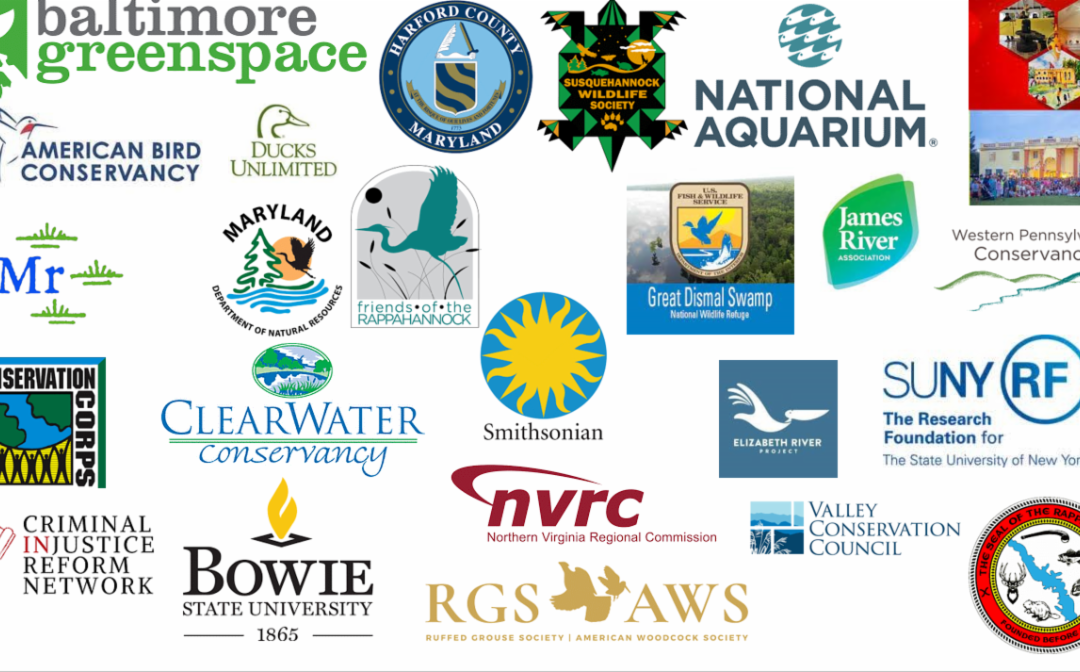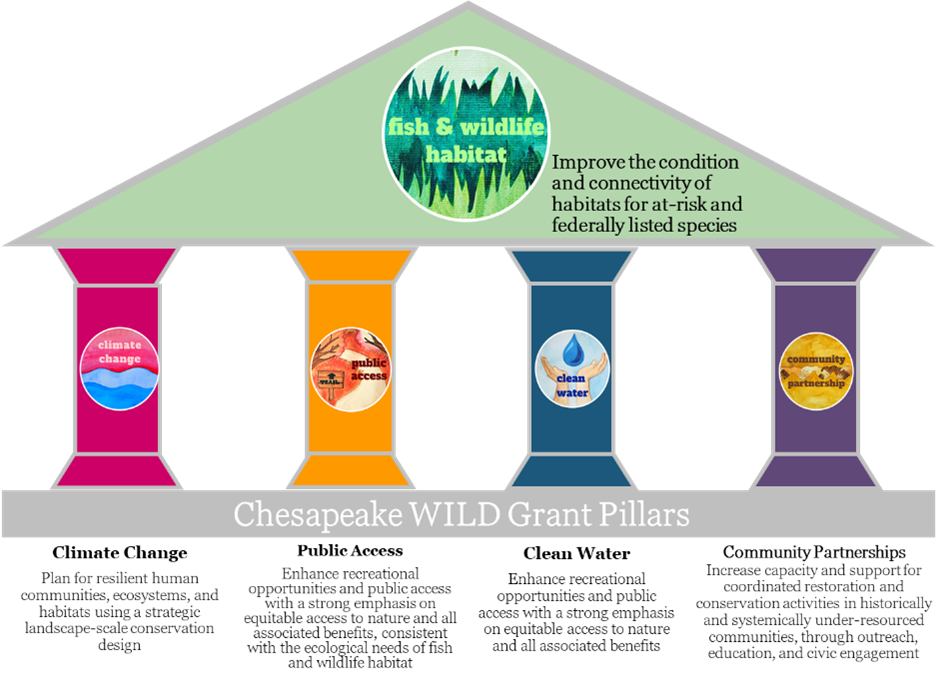Chesapeake WILD 2023 Grant Recipients
Written by: Jamal Childs
The Chesapeake Watershed Investments for Landscape Defense (WILD) Program, fondly known as Chesapeake WILD, takes center stage today as we delve into its crucial grantmaking component. Our focus is on celebrating the outstanding 2023 award recipients whose efforts are leaving an indelible mark on the Chesapeake Bay watershed. This expansive watershed, the largest estuary in the United States, is a diverse tapestry of natural resources, hosting everything from headwater creeks and streams to large rivers, intact forests and agricultural lands. Chesapeake WILD grantmaking is pivotal in the restoration and conservation of these vital living resources.
This year Chesapeake WILD awarded more than $7.4 million to 25 new implementation or planning and technical assistance grants, which generated over $12 million in matching contributions, resulting in a total conservation impact of more than $19.4 million. The awards will ultimately improve recreational access along more than 31 miles of river and trails, restore more than 32 riparian miles of forest habitat, improve passage along nearly 120 river miles for migratory fish species, and protect more than 4,700 acres of fish and wildlife habitat, including 2,000 acres of key wildlife corridors in high-elevation areas that will allow species to shift habitats in response to climate change. Many of these projects address conservation needs in vulnerable communities.
Extending from Cooperstown, New York, to West Virginia’s Fairfax Stone, and finally reaching Norfolk, Virginia, the Chesapeake Bay watershed is a harmonious blend of natural elements and human communities. It encompasses streams, small creeks, large rivers, forests, grasslands, wetlands, agricultural lands, small towns, suburbs and cities. The Chesapeake Bay itself, a majestic estuary, supports an impressive array of life—approximately 3,600 species of plants and animals, including 348 species of finfish, 173 species of shellfish and 2,700 species of plants. The Bay is a crucial habitat for nearly one million waterfowl during winter, constituting one-third of the Atlantic Coast’s migratory birds. The ecological well-being of the watershed is intricately tied to the health, prosperity and enjoyment of over 18 million people residing, working and recreating in the region.
The WILD program pillars.
As we applaud the efforts of the 2023 award recipients, it’s crucial to understand the comprehensive approach Chesapeake WILD adopts in addressing the challenges faced by the Chesapeake Bay watershed. The competitive grant program responds to a partner-identified need for coordinated action to restore, conserve, and protect a resilient and connected landscape of healthy lands and waters. An intact, functioning watershed supports a diversity of wildlife, fish, and plants, and contributes to the social health and economic vitality of all who live, work, and recreate in the Chesapeake Bay watershed.
The first priority area focuses on habitat improvement for imperiled fish and wildlife by strategically investing in habitat restoration and connectivity to allow for the free movement of wildlife essential for maintaining biodiversity.
Public access to nature takes center stage in the second pillar. Chesapeake WILD recognizes the importance of ensuring that all communities, regardless of socioeconomic status, have meaningful access to the natural resources within the watershed. This involves community engagement initiatives, educational programs and recreational opportunities that foster a sense of stewardship and connection to the environment.
The third pillar addresses climate change and resilience in both natural and human communities. With the looming threat of climate change, this aspect of Chesapeake WILD’s work is crucial. By investing in projects that enhance the resilience of ecosystems and human communities alike, the program contributes to the overall sustainability of the watershed. This involves strategies such as restoring natural buffers to mitigate the impacts of extreme weather events and rising sea levels.
Next, the fourth pillar delves into the importance of community partnership and collaborative action. Recognizing that the challenges faced by the Chesapeake Bay watershed are multifaceted, Chesapeake WILD actively fosters partnerships at various levels. Collaborating with federal, tribal, state and local governments, as well as community organizations, allows for a more coordinated and impactful approach to conservation efforts. This collaborative spirit extends to the Chesapeake Conservation Partnership (CCP) and Chesapeake Bay Program, creating a synergy that maximizes the collective impact of all stakeholders.
The fifth and final pillar represents improved water quality. Chesapeake WILD encourages innovation. In an ever-changing environment, staying ahead of the curve is essential. By promoting innovation, the program seeks creative and sustainable solutions to emerging challenges. Moreover, leveraging matching funds amplifies the financial impact of conservation efforts, attracting additional resources and support for the cause.
A cornerstone of Chesapeake WILD’s success lies in its commitment to equity and justice in conservation planning and actions. This is not just an abstract principle; it is a guiding force in every facet of the program. By ensuring that underserved communities are not only included but play a meaningful role in conservation efforts, Chesapeake WILD acknowledges the intrinsic value of diverse perspectives and experiences in shaping a sustainable future. The Chesapeake WILD program’s emphasis on a holistic approach to conservation is evident in its recognition that the health of the watershed depends on the intricate interplay of various elements. It’s not merely about preserving one aspect of the ecosystem but understanding the delicate balance that sustains the entire Chesapeake Bay watershed.
For those inspired by the impactful stories of the 2023 award recipients and eager to contribute to the Chesapeake WILD Program, we invite your organization to participate in the emerging Chesapeake WILD Roundtable. Becoming part of this network opens avenues for participation, whether through grant applications, encouraging others to align their conservation ideas with the program’s pillars, or simply spreading awareness about the critical importance of restoring and protecting the living resources of the watershed.
CCP extends a heartfelt acknowledgment and gratitude to the conservation partners whose unwavering support, dedication and thoughtful engagement make the Chesapeake WILD Program possible. Through the collective efforts of individuals, organizations and communities, we can truly make a lasting positive impact on the Chesapeake Bay watershed, ensuring its vitality for generations to come. The stories of the 2023 award recipients are not just a celebration of current achievements but also are a call to action for a shared commitment to the future well-being of the Chesapeake Bay watershed’s living resources.
Image credit:
- Jamal Childs
- NFWF
- NFWF
Lightning Update is a regular communication of the Chesapeake Conservation Partnership. Any opinions expressed are those of the authors and do not necessarily reflect positions of the Partnership or member organizations.
To share a success story, news, or important event, send your information to:
Support for the Chesapeake Conservation Partnership is provided by:
National Park Service Chesapeake
EPA Chesapeake Bay Program
USDA Forest Service
Pennsylvania Department of Conservation & Natural Resources
Maryland Department of Natural Resources
Virginia Outdoors Foundation
US Fish & Wildlife Service
Chesapeake Conservancy
The Chesapeake Conservation Partnership is co-convened by:





